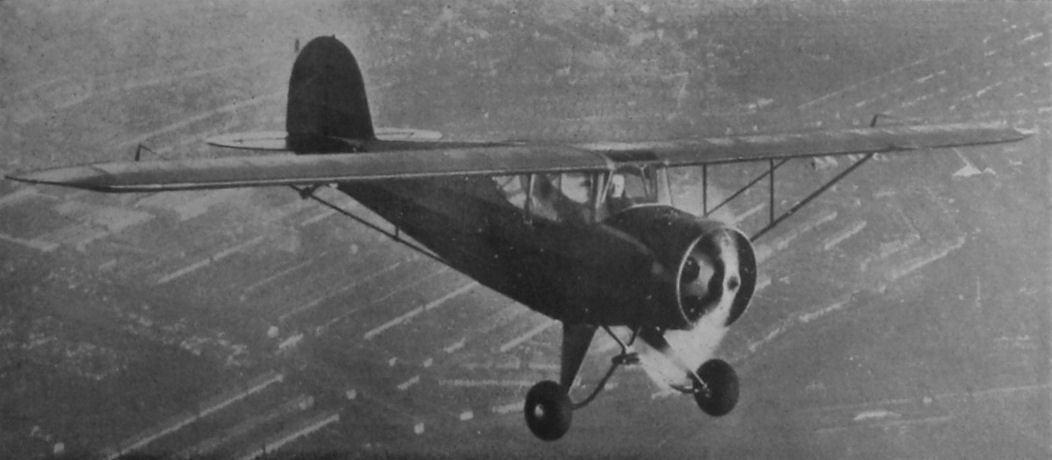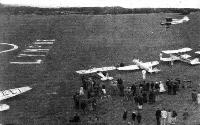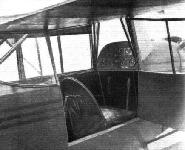
Porterfield Flyabout
Легкий самолет Wyandotte Pup был спроектирован Ноэлем Хокадэем и построен в качестве студенческого проекта учащимися канзасской средней школы старших классов "Wyandotte High School". Самолет настолько заинтересовал компанию "Porterfield Aircraft Corporation" (также из города Канзас-Сити), что она выкупила права на него. На основе Wyandotte Pup в 1935 году нанятый компанией Ноэль Хокадэй спроектировал другой самолет, получивший обозначение Porterfield Model 35 Flyabout.
Новый самолет представлял собой моноплан с высокорасположенным подкосным крылом, кабиной на двух человек, неубирающимся шасси с хвостовым костылем и звездообразным двигателем LeBlond 5D мощностью 60 л. с. (45 кВт). В 1937 году на самолет установили двигатель LeBlond 5DE мощностью 70 л. с., он получил новое обозначение Model 35-70 Flyabout. Позже появились и другие варианты машины: Model 35-V с двигателем Velie M-5 мощностью 65 л. с.; Model 35-W, известная также как De Luxe Sport или Model 90, со звездообразным двигателем Warner Scarab Junior мощностью 90 л.с. Всего выпущено 250 самолетов, часть пошла на экспорт.
ТАКТИКО-ТЕХНИЧЕСКИЕ ХАРАКТЕРИСТИКИ
Porterfield 35-70 Flyabout
Тип: двухместный моноплан
Силовая установка: один звездообразный ПД LeBlond 5DE мощностью 70 л. с. (52 кВт)
Летные характеристики: максимальная скорость 185 км/ч; практический потолок 4570 м; дальность 579 км
Масса: пустого 366 кг; максимальная взлетная 594 кг
Размеры: размах крыла 9,75 м; длина 6,17 м; высота 2,01 м; площадь крыла 13,66 м2
Описание:
- Porterfield Flyabout
- Flight, January 1937
ECONOMICAL TRANSPORT for TWO
Фотографии
-
Jane's All the World Aircraft 1938 / 03 - All the world's aeroplanes
The Porterfield 35 Two-seat Light Cabin Monoplane (70 h.p. Le Blond engine).
-
Flight 1937-03 / Flight
The American private-owner type: The Porterfield
-
Flight 1937-01 / Flight
Регистрационный номер: G-AEOK [3] The general layout of the Porterfield "70" and the pilot's range of view are adequately shown in this Flight photograph of the machine flying near Croydon.
-
Aeroplane Monthly 1988-05 / Personal album. Civil
Регистрационный номер: G-AEOK [3] Porterfield Flyabout 35-70 G-AEOK, photographed at Lympne in 1937. It was imported by Surrey Flying Services at Croydon as a sales demonstrator. The standard Porterfield colour scheme was black and orange.
-
Air-Britain Archive 1982-03
Регистрационный номер: ZK-AFS A rare shot of Porterfield 35-90 ZK-AFS which unfortunately survived in New Zealand for only one year before being destroyed in a fire. Two of these Warner Scarab powered models appear in the extract below and the other, ZK-AFT, is still in existence in non-flying condition at Wigram.
-
Air-Britain Archive 1984-03
Регистрационный номер: ZK-APJ, NZ598 Porterfield ZK-APJ carried three different civil registrations in less than ten years in NZ, it recently featured on a "Digest" front cover as NZ598.
-
Flight 1937-01 / Flight Advertisements
A completely equipped cabin 2-seater cruising at over 100 m.p.h., with a 24-25 miles-to-the-gallon consumption and 40 m.p.h. landing
-
Flight 1936-12 / Flight
ANOTHER INVADER: The agency for this machine, the American Porterfield 70, has been obtained by Surrey Flying Services. With a 70 h.p. Le Blond engine this tandem-seater cabin monoplane cruises at 105 m.p.h. and will cost ?625 over here.
-
Мировая Авиация 217
Регистрационный номер: N20748 Porterfield Model 35 Flyabout выпускался в вариантах с различными двигателями. На фотографии - Model 35-W-90 с двигателем Warner Scarab Junior мощностью 90 л. с.
-
Flight 1937-08 / Flight
Between heats and final mechanics tinkered, while spectators watched demonstrations of the Wicko, seen flying above, the Porterfield "70" and the German Fieseler with 70 h.p. Hirth engine.
Другие самолёты на фотографии: Fieseler F-4 / F-5 - Германия - 1933Foster Wikner Wicko - Великобритания - 1936
-
Air-Britain Archive 1984-02
Регистрационный номер: G-AEOK [3] IN BELGIUM: The Beechcraft C.17R exhibited at the Brussels Show by Aviquipo. Surrey Flying Services did some high-pressure work in installing the machine at the show after it had been held up at Croydon awaiting an export licence. Incidentally, a rather novel brochure, "A Day in the Life of a Beechcraft," containing copies of an American commercial log, is issued by Surrey's at Croydon.
Beech 17 G-AESJ (c/n 118) on the stand at the First International Aircraft Exhibition at Brussels in May/June 1937. Visible behind are Porterfield G-AEOK, Koolhoven FK53 PH-FKJ and SABCA S30 OO-AVB.Другие самолёты на фотографии: Beechcraft Model 17 Staggerwing - США - 1932Koolhoven FK-53 - Нидерланды - 1936SABCA S.30 - Бельгия - 1936
-
Flight 1937-02 / Flight
The cabin and front seat of the tandem-seater Porterfield monoplane, which cruises at 100 m.p.h. on a 70 h.p. Le Blond radial.
- Фотографии











